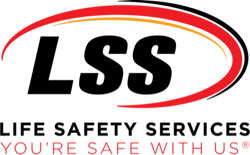.jpg?width=1536&name=Requirements%20for%20Annual%20Fire%20Door%20Testing%20%20Blog%20Image%20(1).jpg)
Fire doors are an important component in the fire safety industry and are very popular among fire safety professionals. Like dampers, fire doors are a method of passive fire protection used to prevent the spread of fire and smoke between fire barriers. Not only do they keep fire from spreading throughout a building, but they also provide a passage way for those to escape during a fire.
However, fire doors can be complicated devices. There are many different assemblies that go into making a fire door function. If not all of the parts a working then the fire door will not be able to properly do its job. Therefore, fire door requirements for annual testing can be challenging and needs a knowledgeable professional in the field to perform the annual inspection as accurately as NFPA 80 requires.
Fire door assemblies are designed to provide adequate time for building occupants to escape a burning building during the event of a fire. Additionally, these assemblies protect the structure long enough to give firefighters ample time to extinguish a fire during a fire event." Swinging fire doors and fire door assemblies are a major component of egress that need to reliably function.
Fire Door Requirements For Annual Testing
5.2.4 Swinging Doors with Builders Hardware or Fire Door Hardware.
Inspection Points per NFPA 80 5.2.4.1 - Fire door assemblies shall be visually inspected from both sides to assess the overall condition of door assembly.
5.2.4.2 As a minimum, the following items shall be verified:
(1) No open holes or breaks exist in surfaces of either the door or frame.
(2) Glazing, vision light frames, and glazing beads are intact and securely fastened in place, if so equipped.
(3) The door, frame, hinges, hardware, and noncombustible threshold are secured, aligned, and in working order with no visible signs of damage.
(4) No parts are missing or broken.
(5) Door clearances at the door edge to the frame, on the pull side of the door, do not exceed clearances listed in 4.8.4 and 6.3.1.
(6) The self-closing device is operational, that is, the active door completely closes when operated from the full open position.
(7) If a coordinator is installed, the inactive leaf closes before active leaf.
(8) Latching hardware operates and secures the door when it is in the closed position.
(9) Auxiliary hardware items that interfere or prohibit operation are not installed on the door or frame.
(10) No field modifications to the door assembly have been performed that void the label.
(11) Gasketing and edge seals, where required, are inspected to verify their presence and integrity."
That’s a lot to check and maintain on a fire door! But in order for them to work properly they must meet these fire door requirements. LSS’ fire door inspection protocol is one of the industry’s most detailed. Not only does our certified fire door inspection team ensure that your fire doors are code compliant and are working properly but they also provide you with proof for you AHJ with the best report in the business.
If your fire doors are not being tested and inspected every year, as required by the NFPA, they may be out of compliance and can potentially put lives at risk. Contact Us Here or call today at 888-675-4519 to learn more about how we can help you with your fire door requirements for annual testing.

